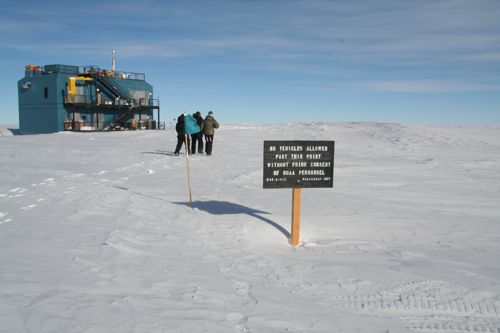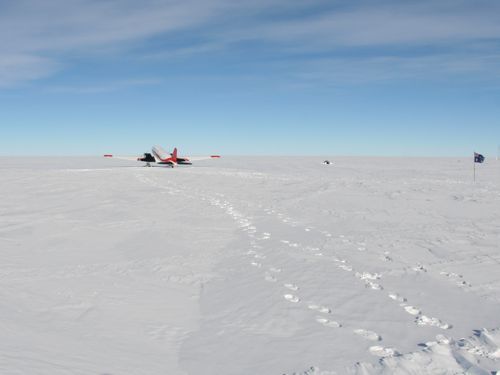Here at the south pole, many groups are doing scientific research on a wide variety of topics. IceCube is looking at neutrinos from space; there are several other research projects involving cosmic background radiation from space as well. But the other day I visited a site where the research is a little closer to home. The ARO (Atmospheric Research Observatory), run but NOAA (National Oceanic and Atmospheric Administration), takes data on Earth's atmosphere and tracks various cycles and changes in the air we breathe.
The South Pole is unique in many ways, and the ARO facility takes advantage of the fact that the wind almost always blows in from one direction, and there's nothing in that direction for a thousand miles. No sources of pollution, no living things, just air blowing along across vast plains of snow. The larger particles of dust, soot, and pollution have long since fallen out. Because of this, the air is considered the cleanest air in the world.
The Clean Air Sector is actually marked out on maps of the South Pole, and includes a specific angle of longitudes, and officially extends for hundreds of kilometers out, and 2000 meters up. Vehicles are prohibited in this vast area except under certain official circumstances, to avoid adding any pollution.
 These signs warn people not to use vehicles in the Clean Air sector. Vehicles would contaminate the air with small amounts of CO2 and other pollutants, messing up the data.
These signs warn people not to use vehicles in the Clean Air sector. Vehicles would contaminate the air with small amounts of CO2 and other pollutants, messing up the data.
The ARO scientists take samples of the air coming from the Clean Air Sector and measure it for various things like greenhouse gases (carbon dioxide, methane, sulfur hexafluoride) and also take measurements on solar radiation, ozone concentration, and albedo (reflectivity of the snow surface). All these measurements are compared to similar data taken at research stations around the world, and have been used to help predict the effects of climate change.
 This graph apparently represents the longest continuous record of atmospheric CO2 data. Note the general trend is certainly increasing over the past 50+ years. Look closely and you will see minor ups and downs each year - during summer, southern hemisphere plants absorb CO2 creating a dip and during winter, the CO2 rises again as plants drop their leaves.
This graph apparently represents the longest continuous record of atmospheric CO2 data. Note the general trend is certainly increasing over the past 50+ years. Look closely and you will see minor ups and downs each year - during summer, southern hemisphere plants absorb CO2 creating a dip and during winter, the CO2 rises again as plants drop their leaves.
 This graph is sweet! Vertical axis shows amount of CO2 in parts per million. Latitude axis shows location on Earth's surface, from north (upper left) to south pole (lower right). As time passes, note the up-down cycle especially in the northern hemisphere - during summer, plants absorb a lot of CO2 bringing down the graph. During winter, it goes back up. Southern hemisphere summer happens 6 months later, and since there is less land (and less vegetation), the rises/falls are smaller. Note the overall trend is that CO2 levels are rising worldwide.
This graph is sweet! Vertical axis shows amount of CO2 in parts per million. Latitude axis shows location on Earth's surface, from north (upper left) to south pole (lower right). As time passes, note the up-down cycle especially in the northern hemisphere - during summer, plants absorb a lot of CO2 bringing down the graph. During winter, it goes back up. Southern hemisphere summer happens 6 months later, and since there is less land (and less vegetation), the rises/falls are smaller. Note the overall trend is that CO2 levels are rising worldwide.
 A mad scientist-style apparatus used for taking samples of clean air and analyzing them for various chemicals and components.
A mad scientist-style apparatus used for taking samples of clean air and analyzing them for various chemicals and components.
 Nick Morgan of NOAA collects small samples of air in a glass jar. Visitors are often given samples of the cleanest air in the world as a souvenir! I will save mine until the air is really polluted, then crack it open for a nice whiff of clean air.
Nick Morgan of NOAA collects small samples of air in a glass jar. Visitors are often given samples of the cleanest air in the world as a souvenir! I will save mine until the air is really polluted, then crack it open for a nice whiff of clean air.
 Here at the south pole, the world is your freezer. These otter pops are probably far colder here outside than in your freezer at home. But probably just as tasty!
Here at the south pole, the world is your freezer. These otter pops are probably far colder here outside than in your freezer at home. But probably just as tasty!
 On the roof of the ARO, many instruments continually track the amount of solar radiation throughout the year.
On the roof of the ARO, many instruments continually track the amount of solar radiation throughout the year.
 These wind turbines are being tested as possible sources of wind energy. The wind blows nearly constantly here, nearly always from the same direction, and rarely very forcefully - so wind power would be an excellent green technology to implement!
These wind turbines are being tested as possible sources of wind energy. The wind blows nearly constantly here, nearly always from the same direction, and rarely very forcefully - so wind power would be an excellent green technology to implement!
 This plane carried a group of maybe 20 tourists to the south pole (note the footprints leading away from the plane). The tourists are given a tour, but not allowed to stay in the station (note the tiny building to the right - that's the bathroom they get to use). They stay for a couple of hours, take photos at the pole markers, then get back on the plane. How much does a person pay for the privilege of being a south pole tourist? Apparently $40,000!
This plane carried a group of maybe 20 tourists to the south pole (note the footprints leading away from the plane). The tourists are given a tour, but not allowed to stay in the station (note the tiny building to the right - that's the bathroom they get to use). They stay for a couple of hours, take photos at the pole markers, then get back on the plane. How much does a person pay for the privilege of being a south pole tourist? Apparently $40,000!
